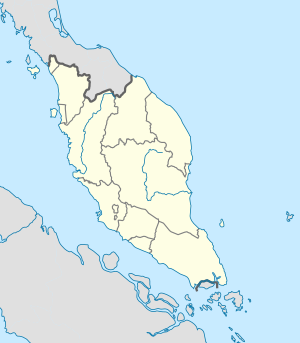Seremban
|
Seremban Soghomban, Sungei Ujong |
||
|---|---|---|
| State Capital | ||
| Other transcription(s) | ||
| • Jawi | سرمبن | |
| • Chinese | 芙蓉 | |
 |
||
|
||
| Nickname(s): Somban | ||
| Motto: 5S The Foundation of Work Excellence | ||
| Location of Seremban in the Malaysian peninsula | ||
| Coordinates: 2°43′N 101°57′E / 2.717°N 101.950°ECoordinates: 2°43′N 101°57′E / 2.717°N 101.950°E | ||
| Country | Malaysia | |
| State | Negeri Sembilan | |
| District | Seremban District | |
| Establishment | 1840 | |
| Granted municipal status | 1979 | |
| Government | ||
| • Administered by | Majlis Perbandaran Seremban | |
| • Yang DiPertua (President) |
Dato' Haji Abd. Halim | |
| Area | ||
| • State Capital | 959 km2 (370 sq mi) | |
| • Metro | 2,980 km2 (1,150 sq mi) | |
| Elevation | 79 m (259 ft) | |
| Population (2010) | ||
| • State Capital | 555,935 (9th) | |
| • Density | 489.00/km2 (1,266.51/sq mi) | |
| • Metro | 806,920 | |
| • Demonym | Serembanese | |
| Time zone | MST (UTC+8) | |
| • Summer (DST) | Not observed (UTC) | |
| Postal code | 70xxx, 71xxx | |
| Mean solar time | UTC + 06:46:48 | |
| National calling code | 06 | |
| License plate prefix | Nxx (for all vehicles include taxis) | |
| ISO 3166-2 | MY-14 | |
| Website | mpsns |
|
Seremban (Jawi: سرمبن; Chinese: 芙蓉, Negeri Sembilanese: Soghomban or Somban) is a town and the capital of Negeri Sembilan, Malaysia, located within Seremban District. The town's administration is run by the Seremban Municipal Council. On 9 September 2009, Seremban was to be declared as a city; however it was later deferred due to technical reasons. However, the idea of granting city status has been brought up again and Seremban is expected to become a city in the near future.
Seremban was originally founded as Sungei Ujong (or Sungai Ujong), named after a nearby river of the same name. While the town was renamed Seremban thereafter, the Sungai Ujong name most prominently persists as a street name for a road adjoining the southern side of town (Sungai Ujong Road, or Jalan Sungai Ujong).
The town is also referred alternately as "Fu Rong" (Chinese: 芙蓉,literally"hibiscus") among the Chinese-speaking community.
Sungai Ujong came into existence with the discovery of tin ore in the 1870s like most major towns in Peninsular Malaysia. The discovery of tin in a nearby area called Rasah, saw an influx of Arab, Malay and Chinese immigrants to work on the mines and trade there. Most of the local Malays were farmers.
Renamed to Seremban, the town flourished not only as a mining area but also a business centre. The Linggi River served as the sole outlet to ferry tin and supplies in and out of the town. Revenue came not only from tin trade but also from the large amount of taxes collected, much to the displeasure of the traders and the British colonialists at the neighbouring port of Malacca.
The local chieftains, namely the Dato' Kelana and the Dato' Shahbandar of Sungai Ujong were at odds with each other on the rights to collect taxes and ownership and control of the mines. The rivalry to assert influence and authority opened the door for British intervention in Negeri Sembilan. The British sided with the Dato' Kelana upon invitation and defeated the forces of the Dato' Bandar who was later sent into exile to Singapore. In a show of gratitude to the British for helping him win the war, the Dato' Kelana had no choice but to accept a British Resident whose job was to advise him on matters other than religion and Malay customs.
...
Wikipedia


